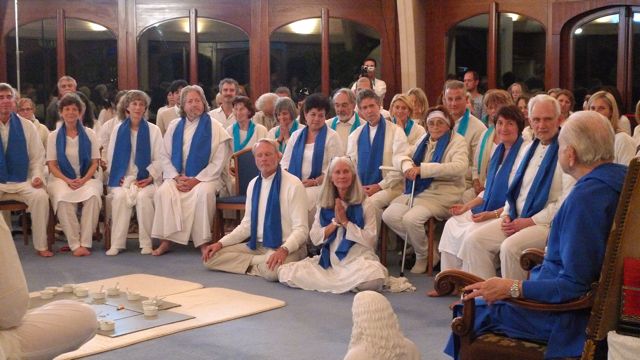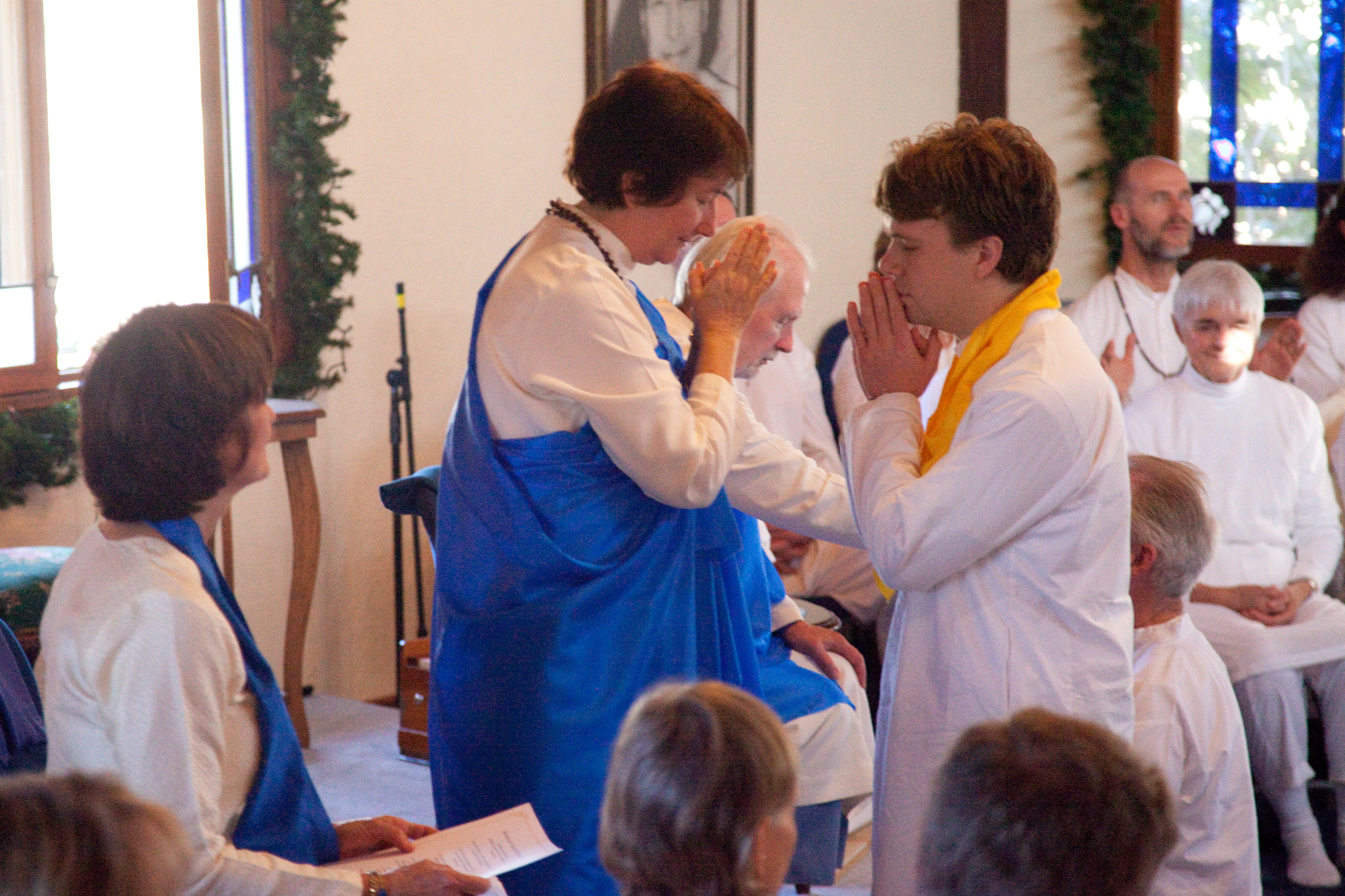Last weekend I wrote an email to my family, sharing with them about the lifetime monastic vow that I took on Christmas Eve at Ananda Village.
In the email, I wrote,
This is something that I’ve been hoping to do for years — so, understandably, I’m thrilled about it.
What changes for me? Outwardly, very little. The vows aren’t “I renounce the world” kind of vows, but more, “I want to live for God alone” kind of vows. (I often think of “God” as “Divine Joy.”) The way I’ve been living already is simply the way I’ll keep living.
Yellow is my monastic color, so I wear yellow shirts now, but it looks pretty normal — you wouldn’t think it at all unusual! (The color is yellow because a pure, golden orange-yellow is symbolic of calm, or joyful, wisdom.) I was already doing this when I visited a few weeks ago.
Inwardly, I’m making the effort to dedicate myself more completely to my chosen path of meditation and yoga, which has already been a transforming experience for me over the past several years. If we’ve talked about it much, you probably already know this.
One of my most noticeable outward changes is a new title: “Brahmachari.” This means “flowing with Brahma,” or “flowing with God.” So my full name now is “Brahmachari Nabha.” There’s no need for you to use the title — I only want you to know so you aren’t bewildered when it appears online and in my emails.
Apart from all this, I’m still as you know me — with all that this entails!
If you have any questions, I’d love to share more, I just don’t want to impose on anyone. In any case, thank you for being a part of such a beautiful, loving, and supportive family. It is something that I always appreciate when I come visit and get the chance to spend time with you.
I didn’t know for sure what kind of a response I’d get, but my family — including grandparents, parents, cousins, and brother — are supportive of the spiritual life choices I’ve made. I was on pretty safe ground expressing myself this way. Also, they all knew that I’ve lived as a monk for years.
One of my grandmothers wrote to ask more about what all this meant, what interested me in Ananda in the first place, what renunciation was about, and how we practiced it. I’m answering her separately, but I’d like to share the thoughts with you, too.
What Vow Did I Take?
I took the vow of brahmacharya in the Nayaswami Order, founded by Nayaswami Kriyananda a few months ago. More than 70 others at Ananda Village took vows on the same day — most of them becoming swamis, or, as they are called in this order, nayaswami. Initiations have also been held in Italy (pictured below), Palo Alto, Seattle, and India.
Why Live a Spiritual Life?
The goal of the spiritual life is Divine Joy — a union of our little self, the ego, with the infinite Self, God. This is a truth expressed in all religions, though not always grasped by the followers of those religions.
Meditation is one way to forget ourselves and experience God-as-Joy directly. Early experiences of Him often comes as peace, which Yogananda compared to a cooling mist, or a weightless waterfall.
Service is another way, because thinking of others’ needs can help us to expand beyond our own.
But in all of this, the goal is the same: renounce our little selves, our little ego with its “needs” and daily desires, and become a part of something much bigger and more beautiful, the vast tapestry of life; and to live in Divine Joy.
That is pretty abstract. It is what got me interested in being part of Ananda, though, which my grandmother asked about.
What Makes Ananda Special?
Until I found the yogic teachings, my religious experience was mainly with mainstream Christian churches. Compared to finding union with “ever-existing, ever-conscious, ever-new joy” — according to Yogananda, a good definition of God — the goals they had were very low.
By my first day as a Christian, I had already attained the heights that most of my peers aspired to: believe in God, believe in Jesus, and don’t be a bad person. These are good things, no doubt, but I came to feel that they weren’t enough.
With Ananda, I found many people who sincerely wanted to dedicate themselves to the highest that they could, saying, “I want to find true, eternal joy; to this I give my life.” And also, “I want to help those who want to, to do the same, regardless of their path.”
The sincerity of their dedication is still something I admire, even after years of living at Ananda Village.
What Do Members of the Nayaswami Order Renounce?
It can be hard to tell from the outside. If you came to visit Ananda Village, you’d see a community of men and women with jobs and bank accounts, getting up, making breakfast, meditating together,  going to movies, getting the car fixed, working in their gardens on the weekend, and doing many other normal, everyday activities, which of course vary from person to person.
going to movies, getting the car fixed, working in their gardens on the weekend, and doing many other normal, everyday activities, which of course vary from person to person.
You’d see that they are good people, and happy, but also that they are people like you and I.
What is unusual is something they have inside: their goals in life are centered on realizing that what they truly are is the soul: a part of us that stretches beyond this lifetime, and is said to be changeless and eternal.
Contrast that with what many people’s goals are focused on: the stuff of daily life: the garden itself, the new car, or the new husband or wife.
It’s that narrow focus, rather than the stuff itself, that members of the Nayaswami Order are making the effort to renounce. They want to give up identifying with a passing reality in favor of identifying with something much greater.
There’s an emphasis here on inner renunciation, which is different from past forms of monasticism. So I can’t compare it easily with traditions that you might already be familiar with. As Nayaswami Jyotish recently put it, the classic vows of Christian monastics — poverty, chastity, and obedience — or Ananda’s equivalent, simplicity, chastity, and cooperative obedience — are still very important, but they can’t be the focus, because we can have them and still not have God.
The Renunciate Vow of Brahmacharya
 A brahmacharya-color scarf
A brahmacharya-color scarf
There are four vows in this renunciate order: the vow of the pilgrim, which anyone can take; the vow of brahmacharya, for people who are single; the vow of tyaga, for (usually married) couples; and the vow of nayaswami, a vow of complete renunciation for people who are single or for married couples.
More detailed explanations of the brahmacharya, tyaga, and nayaswami vows are in the chapter of A Renunciate Order for the New Age, The Vows of Renunciation. The vow of the pilgrim is new, so there isn’t yet any comprehensive information online about it. (I believe Nayaswami Kriyananda will be adding it to the book first.) If you’re interested in taking that vow, or any of these vows, please fill out this form.
I took the vow of brahmacharya, so I’ll quote from it to talk about on what I’ve made a commitment to, and what others do when they join this order.
Excerpts from the Vow of Brahmacharya
In pursuit of that goal [of seeking God], I offer my own life unreservedly to seeking my Divine Source.
In other words, “I want to find God (Divine Joy), and I’m giving it everything I possibly can.”
I will retain no ego-gratifying goal in my life, but will strive always, and above all, to please God.
To me this means, “I don’t want to serve my little self, my petty desires, my passing likes, dislikes, and selfish thoughts — I want to live only for the attainment of Divine Joy.”
It would be hard to make such a definite commitment if I hadn’t already (by God’s grace) experienced some (small) part of this joy in meditation. Even a slight touch of it is more interesting than any other experience.
I renounce attachment to things, people, places, and all self-definitions…
Traditionally, monastics have often taken vows of poverty, which I mentioned earlier. This is so they don’t become attached to money or possessions, which might pull them away from their spiritual goals.
This brahmacharya vow makes the firm commitment to renounce the attachment itself, which after all is the important thing to be free of.
This new form of renunciation may still mean living very simply, but it depends on the individual. I do, after all, live in a canvas tent. On the other hand, it has electricity, heat, a laptop, and an iPhone!, which I use for service as much as possible, instead of just for entertainment.
These are just excerpts. For those who are interested, here is the complete Renunciate Vow of Brahmacharya.
What It Was Like to Take the Vow
Christmas Eve morning found over 100 devotees filling our largest temple at Ananda Village
We began the ceremony at 10:00 am after an hour-long meditation. Afterward the meditation, Jyotish gave a short talk, which you can listen to here, or download from The Nayaswami Order website:
https://www.ananda.org/mp3/nayaswami/2009-12-24-initiation-ananda-village.mp3
Jyotish talked about the sacredness of the occasion; about renunciation; and about how one who is ready to dedicate their lives to God is very close to the end of the soul’s long journey through delusion.
His talk ended with an invitation to those taking, first, the brahmacharya vow to come forward. I was in this group, so I stood up and walked to the center area, which you can see in the photos. We knelt, and as Jyotish read the vow a line at a time, we repeated it after him.
We then came forward to be blessed individually and receive a scarf. As Jyotish blessed me, I felt within myself a deep commitment to live for God alone.
After a moment, I rose and stood before Devi, who put a scarf, yellow for the color of brahmacharya, around my neck. In the photo above, you may see what I saw in her expression at the time: her respect for those coming forward, and for the important step on the spiritual journey that this vow signifies.
The room was silent while everyone who had taken the vow came forward one at a time. (This took some time.)
Next, those taking the vow of tyaga rose, repeated the vow, and were blessed; and finally, those taking the nayaswami vow came forward.
The nayaswami vow is the “Vow of Complete Renunciation.” Jyotish said one line of it at time, and those taking the vow repeated it before stepping forward and offer a spoonful of ghee into a blazing fire, placed in the center of the temple. (Ghee is purified butter and symbolizes pure spiritual aspiration.)
The next part of the ceremony was for those taking the vow to prostrate themselves before the fire. This symbolized unconditional surrender to the divine will.
The atmosphere was very still. I imagine that those taking the vow were making a supreme effort to offer their lives to God as completely as they could.
Finally, each person came forward to be blessed and to officially become a swami.
Two and a half hours from the time we had first started the meditation, the ceremony finished with Jyotish offering a few words and leading us in a closing prayer, that we might become free from ego in this lifetime.
Final Thoughts, and How I Decided to Take the Vow
These vows are holy. Just as I felt unusually calm after taking them, for days afterward I noticed an other-worldly joy emanating from those who took the nayaswami vow, the “Vow of Complete Renunciation.” Indeed, I still often noticed it weeks later.
Freedom! Bliss! This is the fruit of a life of renunciation — not a painful emptiness, which so many people imagine it to be.
This renunciate order is just being born; surely, in the years (and centuries) to come, it will change and grow. Certain details about exactly how it will work, we may only discover through day-to-day experience. If you have questions, or if you felt something was confusing in this post, please do mention it in the comments.
Taking a vow of renunciation is something that some here felt unsure about, in part because the idea is so awe-inspiring. Some of us wondered, “Am I worthy?” or, “Can I do it?”
Whether I’m “worthy” or not, I don’t know, but I did have a memorable experience a few weeks ago when I was reading one of the final chapters of A Renunciate Order for the New Age, in preparation for taking the vow.
In this chapter, Nayaswami Kriyananda wrote,
The true renunciate is one who is willing to face any obstacle in his struggle to reach the goal, for he knows that there is no acceptable alternative.… even if he is killed, he knows that he belongs utterly and completely to God alone.
I was starting to question, “Could I be ready for this? What if I’m not? Yes, I’ve already decided to take the vow, but perhaps I should back out…”
As I thought this, a tightness formed around my heart. “No!” some deep part of myself cried, “I must do this! This — the search for God — is my life!”
I felt this was the answer to my question.
In fact, it is the answer for everyone eventually, in the final stages of their soul’s long journey away from God. For there is simply no other way, without at least inner renunciation, to find true happiness.
Related
- A Renunciate Order for the New Age, online for free
- Video, Audio, and Photos on The Nayaswami Order website





